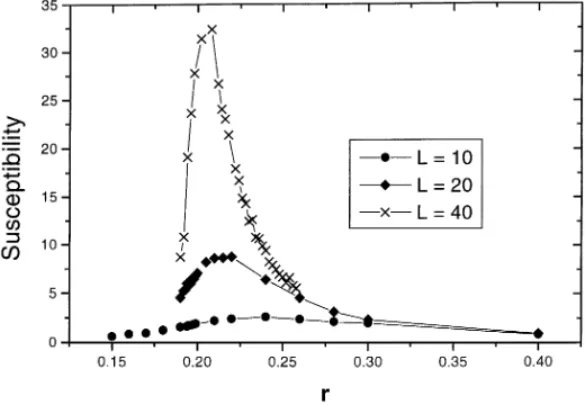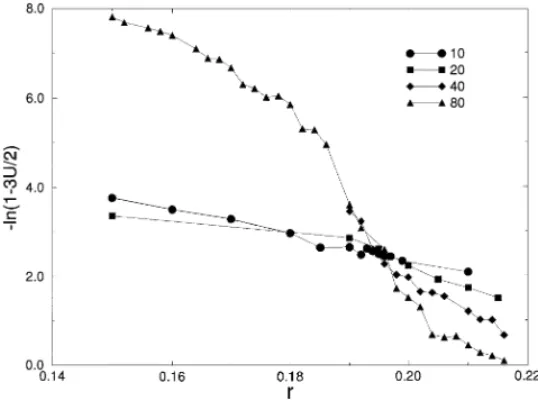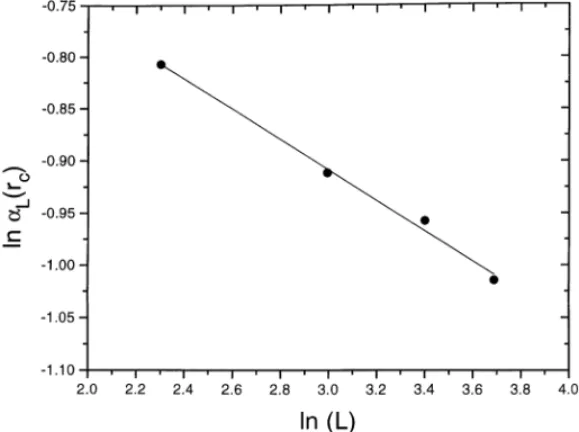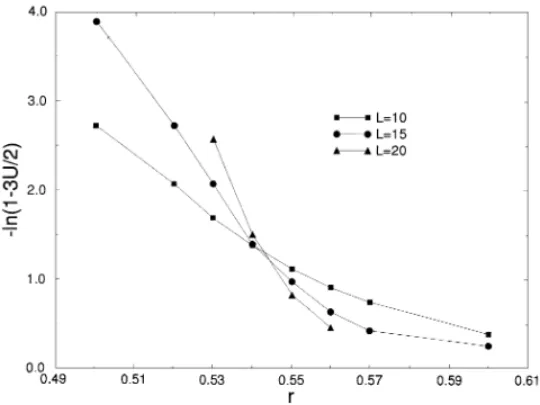Critical behavior of a probabilistic cellular
automaton describing a biological system
Neli R.S. Ortega
a, C. Felipe de S. Pinheiro
b, Tˆania Tome
∗,
J.R. Drugowich de Felcio
baInstituto de Fsica, Universidade de S˜ao Paulo, Caixa Postal 66318, 05315-970 S˜ao Paulo, SP, Brazil bFaculdade de Filosoa, Ciˆencias e Letras, de Ribeir˜ao Preto, Universidade de S˜ao Paulo, 14040-901
Ribeir˜ao Preto, SP, Brazil
Received 26 June 1997; revised 18 December 1997
Abstract
We study nonequilibrium phase transitions occurring in a probabilistic cellular automaton which describes one part of the immune system. In this model, each site can be occupied by three type of cells and the immune response under parasitic infections is described in terms of two parameters p and r. The local rules governing the evolution of this automaton possess “up–down” symmetry similar to Ising models. Performing Monte Carlo simulations on square and cubic lattices we verify that the model displays continuous kinetic phase transitions with spontaneous symmetry breaking. We present detailed simulations and analysis of the critical behavior. Our results indicate that the model belongs to the Ising universality class, supporting the “up–down” conjecture. c 1998 Elsevier Science B.V. All rights reserved
1. Introduction
The universality in nonequilibrium phase transitions is one of the most instigat-ing questions that have been treated in the last decades. One approach in the study of this problem is based on the construction of irreversible stochastic lattice mod-els, that is, stochastic dynamics dened in lattices and composed of irreversible rules. These models do not have an underlying Hamiltonian and are described by the dy-namics itself. Universality in these systems has been studied by approaches which consider an associated Langevin equation to the processes and by considering the fea-tures of the irreversible rules and symmetries of the lattice and order parameter. In these contexts two conjectures have been established: the “up–down” conjecture introduced by Grinstein et al. [1] and the directed percolation conjecture introduced by
∗Corresponding author. Fax: +55 (11) 813 4334; e-mail: ttome@fge.if.usp.br.
0378-4371/98/$19.00 Copyright c1998 Elsevier Science B.V. All rights reserved
Grassberger [2] and by Janssen [3] independently. The “up–down” conjecture says that if a stochastic lattice model evolves according to a dynamics that possesses “up– down” symmetry and respect translational invariance then the continuous kinetic phase transition that could occur in the model is in the universality class of (reversible) Ising model. This means that for these kind of models irreversibility is irrelevant under renormalization. It contrasts to the case of models that have absorbing states for which the critical behavior belongs to the directed percolation class (“directed percolation” conjecture) where irreversibility is important in the criticality even on large scales.
Besides being of great importance in the study of universality in kinetic phase tran-sitions it is notable that stochastic lattice models can be very appropriated to study irreversible processes occurring in systems considered in dierent areas of knowledge. They are specially important to mimic systems in the area of biological sciences, and we can see at least three topics that have been extensively studied: population dynamics [ 4 –6], epidemiology [7,8] and immunology [ 9 –14]. In fact this statistical–mechanical approach, with local rules, takes into account uctuations which can play an impor-tant role in determining the critical behavior of these systems. So, from the point of view of nonequilibrium statistical mechanics and from the point of view of the de-scription of dierent systems in biological sciences, these models are very useful due to their simplicity and capacity of explaining very intricate behavior which is not well understood yet.
Here we consider a probabilistic cellular automaton which was introduced by Tome and Drugowich de Felcio [15] to describe one part of the cellular immune system [11,13,14, 16 –18]. The automaton, which is similar to the one devised by Brass et al. [13,14], was constructed to mimic the part of the immune system constituted by the T-helper cells. The main purpose of the model is to explain the polarization of those cells, i.e. the splitting of theT-helper cells between two kinds, TH1 orTH2, of mature
cells, when the conditions of parasitic infections are varied. As it has been emphasized, in recent studies [ 16 –18], the immune response will depend on which kind ofT-helper cells will predominate on high-level infection. For example, in the case of infection with leishmania [14,18] if TH1 cells predominate the individual will be protected,
otherwise (TH2 response) susceptible. It is important to note that only under a high
enough level of infection the system will give dierent type of immune response. Under low levels of infection the number of TH1 cells is equal to the number of TH2 cells.
This phenomenon is described in the model by the spontaneous symmetry breaking that takes place under a critical level of infection. In Ref. [15] numerical evidences indicated that the model can display a steady state with predominance of one type of cells. Under this condition, the model shows that the immune response is such that the system will be protected or susceptible with respect to one disease.
on the immune response. Our analysis of the critical behavior is basically supported by the assumption that a nite-size scaling hypothesis can be done for the study of the order parameter as well as the variance and the fourth-order cumulant related to the order parameter. From this analysis we obtain the critical exponents. Our results indicate that the model, although not satisfying detailed balance, is in the same univer-sality class of the Ising model. These results corroborate the “up–down” conjecture of Grinstein et al. [1]. It is interesting to note that, in the present model, at each site a dynamical variable is associated that can attain three values. However, the dynamical rules are invariant under the exchange between two of the values of the dynamical vari-ables. This property brings to the problem a symmetry similar to the one found in the Blume–Emery–Griths (BEG) model [21]. In fact, the BEG Hamiltonian is invariant under the exchanging between two of the three values of the spin variable and the line of critical points in this model belongs to the Ising universality class. We also remark that numerical evidences have been found in a variety of models that do not possess detailed balance and fall in the universality class of the Ising model. One example is the majority vote model [22] describing the competition between two Glauber dy-namics. Another example is the critical point with Ising-like behavior observed in the Zi–Gulari–Barshad model [23] with desorption [24].
In the rst section we explain the model and their properties. In the two following sections we describe our Monte Carlo simulations for lattices in two and three dimen-sions as well as the nite-size scaling analysis we performed. Results and discusdimen-sions are presented in the last section.
2. The model
We consider a probabilistic cellular automaton [15] where cells of three types: TH0;
TH1 andTH2 occupy the sites of a regular lattice. To each site we attach a dynamical
variable i that takes the values−1; 0 or +1 as indicated below
cell TH0 TH1 TH2;
i 0 1 −1:
(1)
The dynamical local rules of our model describe the cellular interactions between
TH cells and are composed of two processes. One of them describes the transformation
of a TH0 cell into either TH1 or TH2 cells whereas the other describes the reversed
process. We remark that a TH1 cell never develops into aTH2 cell and vice-versa. The
TH0 cell is transformed into aTH1 (TH2) cell with probability p if the majority of its
nearest neighbors are of the type TH1 (TH2) and remains the same with probability
1−p. When the number ofTH1 and TH2 cells in the neighborhood are the same,TH0
cell is transformed into a TH1 (or TH2) cell with probability p=2: A TH1 (TH2) cell
turns into a TH0 cell with probability r independently of the neighbors and remains
The rules so dened are stochastic and of totalistic type [25]. They can be formally expressed by the transition probabilities per site which in this case will be of the form
wi(i|
′
i; S
′
i) (2)
with S′
i dened as
S′
i= X
i+; (3)
where the sum is done over the rst neighbors of site i in the lattice. In the rst process, in which ′
i= 0; transition probability wi(i|0; S
′
i) depends on
the neighborhood of site i only through the variable S′
i and is given by
wi(1|0; Si′) =
p if S′
i¿0;
p=2 if S′
i=0;
0 if S′
i¡0;
(4)
wi(0|0; Si′) = 1−p (5)
and
wi(−1|0; S
′
i) =
p if S′
i¿0;
p=2 if S′
i=0;
0 if S′
i¡0:
(6)
In the second process, for which ′
i=±1; the transition probabilitieswi(i|1; Si′) and
wi(i|−1; Si′) are dened in terms of r which is related to the mean-life time of cells
TH1 and TH2: a site i, at time ‘, occupied by a TH1 (TH2) cell has the probability r
of being occupied by a TH0 cell at time ‘+ 1. They are given by
wi(0|+1; S
′
i) =wi(0|−1; S
′
i) =r (7)
and
wi(+1|+1; S
′
i) =wi(−1|−1; S
′
i) = 1−r : (8)
We remark that
wi(−1|+1; Si′) =wi(+1|−1; Si′) = 0: (9)
These rules have “up–down” symmetry, that is,
wi(i|
′
i; S
′
i) =wi(−i|−
′
i;−S
′
i); (10)
so that we expect, following Grinstein et al. [1] that this probabilistic cellular automaton be in the same universality class as kinetic Ising models.
We remark that the process TH0→TH1 or TH2 dened by rules (4) and (6) are
able to describe the fact that there is a stimulation in the production of TH1 (TH2)
Also the fact that a majority of one kind does not allow the production of cells of the other type is comprehended. These are important features of the immune response as is detailed discussed in Refs. [13,14].
3. Monte Carlo simulations
We have performed Monte Carlo simulations on hypercubic lattices with periodic boundary conditions. We used lattices with Ld=N sites with synchronized update. In
one dimension we found no ordered state, as expected from the “up–down” conjecture. Simulations run on square and cubic lattices indicate that the system can present a phase transition from a disordered state to an ordered state. Each simulation starts with a conguration generated at random and average over several simulations were taken to get nal results. Each site is updated according to the Markovian rules dened in Eqs. (4) – (9). Then the following procedure is performed: (i) if the site is occupied by a TH0 cell, then a random number is generated and is compared to p. If it is less
or equal to p then the neighborhood is checked to the presence ofTH1 andTH2 cells.
If the sum of the dynamical variables of the neighborhood is greater (less) than zero then the site will be occupied by a TH1 (TH2) cell in the next time step. If the sum is
equal to zero then we generate a random number which is compared to 0.5 to decide if the site will be occupied by a TH1 or TH2 cell. (ii) if the site is occupied by a
TH1 (TH2) cell, then a random number is generated and if it is less or equal to r
then the site will be occupied by a TH0 cell in the next time step. A run is nished
when the system reaches the stationary state. The time taken by the system to reach the stationary state depends on the parameters and on the lattice size L. Discarding the transient, the data were sampled every na time units (na reaching 100 Monte
Carlo steps when r is close to the critical value rc). Our simulations were performed
xing p and varying r. That is for each p we performed simulations for r varying between 0 and 1.
The TH1 and TH2 fraction, x and y, respectively, as functions of r, for a square
lattice, are shown in Fig. 1. We can see that there is a critical valuerc, that forp= 0:3
is rc= 0:196, where a phase transition occurs: for r¡rc the system is in the ordered
phase where x6=y.
We calculated the order parameter
=h|m|i; (11)
wherem=Pii=N. The average is evaluated numerically as described above. We also
compute the “susceptibility”, that is the variance
=N{m2− h|m|i2}; (12)
the Binder cumulant [19]
U= 1−
m4
Fig. 1. TheTH1 andTH2 fraction,xandy, respectively, as functions ofr, forp= 0:3. Simulations run on square lattices withL= 30.
and the surface correlation, introduced in [20],
=h(top)(bottom)i ; (14)
where (top) = 1(−1) if the majority of the sites of the top are in state where i=
+1(−1), and it is zero otherwise. The hypersurfaces designed by top and bottom in previous equation are lines in two-dimensional systems and planes in three-dimensional ones, separated by a distance L=2.
4. Finite-size scaling
To nd the critical exponents we start from the assumption that a nite-size scaling analysis can be done to study the critical properties of this model. We assume that nonequilibrium continuous phase transitions in this model are characterized by a length scale that diverges, in the innite system, as ∼ |rc−r|−whereis the correlation
length exponent. Since the (linear) size of the system L scales like the correlation length then any nite system quantity GL(r) will be a homogeneous function of L
and . From this property it follows that
GL(r) =L=Gb
L
; (15)
or
GL(r) =L=Ge(L1=(r−rc)): (16)
In the limitL→ ∞ we have
G∞(r)∼ |r−rc|
−
Fig. 2. The susceptibilityLas a function of r(p= 0:3) forL= 10;20 and 40 (square lattices). In the innite system we expect that near the critical point the order parameter behaves as
∼ |r−rc|: (18)
From the above analysis it follows that, for a nite system, the following scaling form for the order parameter should be accomplished:
L(r) =L−=f((r−rc)L1=); (19)
where f(x) is a universal function.
We calculated the susceptibility for several values of the lattice size L (square lat-tices) as is shown in Fig. 2. The order of magnitude of the relative error is about 15% in the critical region and less than 5% out of that region. We can see that the susceptibility has a peak for a value of r (xed p). As L is increased this peak turns to be sharper and we assume that for the innite system diverges at the critical point as
∼ |r−rc|
−
: (20)
We also assume a nite-size scaling form for as
L(r) =L=g((r−rc)L1=); (21)
where g(x) is a universal function.
The fourth-order cumulant obeys the following scaling relation
UL(r) =h(L1=(r−rc)); (22)
whereh(x) is a universal function. Whenr→rc then UL(r→rc) =U∗ and it follows
that U∗
Fig. 3. Binder cumulantUL versusr(p= 0:3) for square lattices withL= 10;20, 40 and 80.
not depend on the lattice size. We used the cumulant method [19], which is based on this fact, to determine the critical values rc(p). For Ising models on the square lattice
with periodic boundary conditions, it has been found [26] that U∗
≃0:61.
The surface correlation , dened in Eq. (14), was used as another way of deter-mining the critical parameter rc(p). This quantity, which scales as L0, was proposed
[20,27] in the context of equilibrium phase transitions as a new type of nite-size scal-ing algorithm. Later, it has been shown to be useful even to study far from equilibrium phenomena [28]. From the analysis of it is possible to verify if the system is in a single-domain state (→1) or is not correlated (→0) [29].
In what follows we report the nite-size scaling analysis based on our Monte Carlo simulations. In Fig. 3 we show UL as a function of r for a xed value of p and for
dierent lattice size L. All curves intercept in the critical point rc(p). From these data
we construct the phase diagram, for the square lattice, shown in Fig. 4. The points in the critical line are such that U∗
= 0:607±0:005, except for the point (p; r) = (1;1) where the cumulant results indicate that the transition is not continuous. Fig. 5 shows the search for the critical parameter rc(p) using the surface correlation. The result is
in complete agreement with that obtained by the cumulant method.
From the scaling relation (19) we derive the following expression for r=rc:
lnL(rc) =A−
lnL ; (23)
where A is a constant. To evaluate the ratio of the critical exponents = we plot lnL(rc) with rc obtained from the cumulant results versus lnL as is shown in Fig. 6.
We did this procedure for 0¡p¡1 and estimated this ratio as == 0:126±0:014. From the scaling relation (21) we derive the following relation r=rc:
lnL(rc) =B+
Fig. 4. The phase diagram in ther–pplane for square lattices. Critical points were obtained by the cumu-lant method (continuous line). For the sake of comparison we have included results from pair mean-eld approximation of Ref. [15] (dashed line).
Fig. 5. Surface correlation as a function of rforp= 0:3 and L= 10;20, 40 and 80 (square lattices). The critical value isrc= 0:198±0:002.
where B is a constant and rc is obtained from the cumulant method. The ratio = is
obtained by plotting lnL(rc) as a function of lnLas is shown in Fig. 7. We evaluated
Fig. 6. Log–log plot ofL(rc), withrcobtained from the cumulant results, versusL. The slopes of this line gives the ratio=. We did the same procedure for 0¡p¡1 and estimated this ratio as== 0:126±0:014 (square lattices).
Fig. 7. Log–log plot of L (rc) versusL. The ratio= is obtained by the slope of the line. We did the same procedure for 0¡p¡1 and estimated the ratio== 1:70±0:05 (square lattices).
plot of the fourth-order cumulant against r, for p= 0:3. We found rc= 0:545±0:003
Fig. 8. Binder cumulantUL versusr(p= 0:3) for cubic lattices withL= 10;15 and 20.
5. Conclusions
We have simulated numerically a probabilistic cellular automaton representing the dynamics of three types of biological cells, TH0, TH1 and TH2. The dynamical rules
are invariant under the exchange of TH1 and TH2 cells resulting in an “up–down”
symmetry. The automaton displays one disordered state with the same symmetry which is spontaneously broken, as one varies the parameters, giving rise to a nonequilibrium phase transition and an ordered state with the predominance of either TH1 or TH2.
The numerical results obtained in the square and cubic lattices show that the dis-ordered state is stable, at xed p, for high values of the death probability r. As we decrease r a symmetry breaking takes place at a critical value rc below which the
system is in the ordered phase. We observe that, for xed p, as r is decreased the model always presents a kinetic phase transition. The phase diagram shown in Fig. 4, obtained here from numerical simulations (on square lattices) is qualitatively dier-ent from the one obtained in Ref. [15], where mean-eld approaches have been used. Mean-eld results indicated that the ordered state could be stable for any value ofr for high values ofpwhereas the present results show that, given any value of p¡1, there is always a value rc¡1 above which the system is in the disordered state. We believe
that the present numerical results are in agreement with immunological responses, since the ordered state (immune response dierentiated) should not be stable for any value of r even if p is large. This assertion is based on the following rationale: high values of r correspond to situations where the organism is not exposed to a high level of infection and in this case it should not give a dierentiated immune response, char-acterized by the polarization of TH cells. This phenomenon is experimentally veried
The critical exponents were evaluated from numerical simulations on lattices, of sizes ranging from L= 10 toL= 80, in two dimensions and with the help of nite-size scaling analysis. They are, consistent with Ising-like behavior. The same behavior is observed along all the critical line, except at the point (r; p) = (1;1) where the transition seems to be discontinuous. Preliminary results for the three-dimensional lattice reinforce the hypothesis of universality between this model and Ising one. These results are consistent with the conjecture [1] for which automata whose dynamic rules possess “up–down” symmetry and respect the symmetry of the lattice should belong to the Ising universality class.
References
[1] G. Grinstein, C. Jayaprakash, H. Yu, Phys. Rev. Lett. 55 (1985) 2527. [2] P. Grassberger, Z. Phys. B 47 (1982) 365.
[3] H.K. Janssen, Z. Phys. B 42 (1981) 151. [4] R. Dickman, Int. J. Mod. Phys. C 4 (1993) 271. [5] J.E. Satulovsky, T. Tome, Phys. Rev. E 49 (1994) 5073.
[6] H. Matsuda, N. Ogita, A. Sasaki, K. Sato, Prog. Theoret. Phys. 6 (1992) 1035. [7] P. Grassberger, Math. Biosci. 63 (1983) 157.
[8] N. Boccara, K. Cheong, M. Oram, J. Phys. A 27 (1994) 1585. [9] S.A. Kauman, J. Theoret. Biol. 22 (1969) 437.
[10] G. Weisbuch, H. Atlan, J. Phys. A 21 (1988) L189. [11] F. Celada, P.E. Seiden, Immunol. Today 13 (1992) 56. [12] D. Stauer, G. Weisbuch, Physica A 180 (1992) 42.
[13] A. Brass, R.K. Grencis, K.J. Else, J. Theoret. Biol. 166 (1994) 189.
[14] A. Brass, A.J. Bancroft, M.E. Clamp, R.K. Grencis, K.J. Else, Phys. Rev. E 50 (1994) 1589. [15] T. Tome, J.R. Drugowich de Felcio, Phys. Rev. E 53 (1996) 3976.
[16] T.R. Mosmann, R.L. Coman, Adv. Immunol. 46 (1988) 111. [17] K.J. Else, R.K. Grencis, Immunol. 72 (1991) 508.
[18] P. Scott, H.E. Kaufmann, Immunol. Today 12 (1991) 346.
[19] K. Binder, Applications of the Monte Carlo Method in Statistical Physics, Springer, Berlin, 1984. [20] P.M.C. de Oliveira, Europhys. Lett. 20 (1992) 621.
[21] M. Blume, V.J. Emery, R.B. Griths, Phys. Rev. A 14 (1971) 1071. [22] M.J. de Oliveira, J. Stat. Phys. 66 (1992) 273.
[23] R.M. Zi, E. Gulari, I. Barshad, Phys. Rev. Lett. 56 (1986) 2553. [24] T. Tome, R. Dickman, Phys. Rev. E 47 (1993) 948.
[25] S. Wolfram, Rev. Mod. Phys. 55 (1983) 601.
[26] D.P. Landau, in: V. Privman (Ed.), Finite Size Scaling and Numerical Simulation of Statistical System, World Scientic, Singapore, 1990, p. 223.





